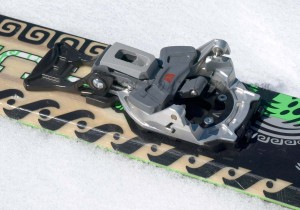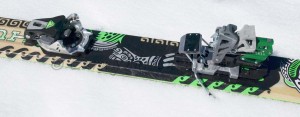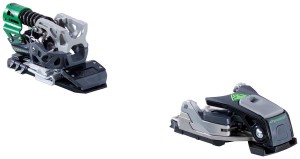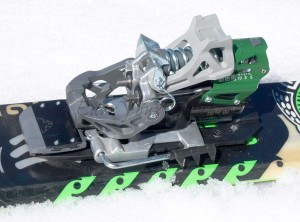Weight is great as long as it comes with a healthy list of functional features and there is no doubt, Dynafit’s Beast increases the limits of downhill performance well beyond what a two-pin binding is known to do, particularly when charging hard and landing harder. The flaw in the ointment isn’t with its downhill ability – it’s with the uphill, and it isn’t because the binding tips the scales at four pounds per pair. The cardinal sin of the Beast is the lack of a flat touring mode.
On the other hand, there are a number of tours that are often done without any meadows, like a one-and-done dawn patrol before work. In that case, who needs a flat touring mode? It’s just a resting gear anyway and these Beasts are made for chewing up vertical, both ways. Which is where you will appreciate Dynafit’s evolution of their two-pin system.
Bomb Squad Material
Until the Beast, if you wanted to really hammer the terrain with a Dynafit binding you had to lock out the release. Pre-release is not a recommended feature at high speeds or with big drops. Those are the very conditions where most any tech binding is known to fail. Anyone who owns a pair knows you can spread the jaws a bit and they will snap back in to place. But if you spread ’em far enough, past the cam lock, they will snap open, disconnecting you from your skis.
With the Beast, Dynafit lets the toe-jaws swivel on a plate, adding game-changing angular range before the jaws inevitably do snap open and release you. By the numbers the toe can rotate 5°, or ± 13mm before letting go. At the heel, the standard 5 mm spacing is eliminated, allowing the full 10mm length of the heel spring bars to be used before the heel lets go. The word from hammerheads testing the retention factor on numerous landings was they hold well. They may not instill the same confidence as a Look Pivot-18, but they are far more confidence inspiring than a locked out Vertical or Radical FT. In my meager attempt to push limits the Beast just purred.
Toe Jam

Beta version of the Beast 16 toe unit. Production version adds ledges for easier entry, and a way for snow to escape the cavity between the arms.
Toe Unplugged (production changes)
According to Dynafit, this was an issue that has been addressed by a redesign of the geometry of the arms opening and closing the two pins. It now takes less pole force to cock the pins open and there is a hole through the front of the binding to allow snow to escape the trap formed by the side arms. I’m sure the binding remains susceptible to icing, but these changes should reduce the frequency, and at least let go of your boot without requiring a hammer. Looking back it was kind of funny, being stuck in a binding that has a reputation for not being substantial enough to hold you in, eh?
While I didn’t have a problem getting in to the binding, the production version will come with a set of ledges under each pin to help with stepping in to the binding. That looks like a no-brainer improvement.
As with any tech binding, when in tour mode it is advisable to lock out release. For the Beast, you simply flip the large black lever forward so it rests on top of the ski. This prevents the toe unit from rotating, or allowing the jaws to subsequently open.
Weeks in advance of their delivery to US retailers Dynafit announced the following changes to the toe of the Beast. In my short time using it I didn’t notice the need for many of these changes, but agree, they all sound like significant improvements.
- The shape of the front unit is redesigned with additional free space to more easily work [with] varying models of ski boots.
- Every binding is calibrated to achieve the right measurement when closed.
- The bushings in the arms are made of a stronger material to improve durability.
- The black tour-mode lever is redesigned. It locks the binding more securely into walk-mode to prevent it from going into ski-mode when not intended.
- The new lever also works as an opening lever for the binding.
- The opening force is reduced and the binding less prone to ice up.
- The base plate has left and right ledges to aid stepping in.
- The closing spring force is higher for a more secure closing.
That’s a Heel of a Beast
On the backside of the binding there are several changes. This new design allows 18mm of forward travel while held by the spring bars on the heel, plus a beefy spring for lateral release with a release value range from 6-16. It’s not DIN, since RVs above 12 aren’t calibrated, but on a linear scale, it’s equivalent to RV 16, same as a Duke. Which means it can absorb big spikes of energy, like landing a 30 footer on flatter terrain than you planned ‘cuz you flew further than expected, or it simply refuses to let go while hammering bumps. (Until you wake up and realize bumps are bad for your knees, the Beast will oblige and let them hammer your cartilage until you surrender.)A New Heel Thingy
One of the necessary evils of using the Beast is the requirement to add a replacement metal heel piece that allows the Beast to latch on to your heel, not just via the standard spring bars inserting into the heel, but also a pair of metal clamps that hold down the top of the heel ledge, giving the heel unit a better grip on the boot to allow it to move a crazy 18mm and still not let go. This is partly to yield increased longitudinal motion so your ski can flex without causing your boot to slide off the spring bars, but also to account for a slightly wider spacing between the spring bars.
Changing the metal heel fitting might have unintended consequences with some boots, which has some makers concerned about potential warranty issues. For boots with replaceable sole blocks, do your homework and double check that there is solid plastic where the side screws attach this new fitting.
Shifting Gears
Switching to tour mode is pretty simple, although the necessity of clicking out of the binding at the toe is absolutely required. A small group of elite users has figured out how to force an older model (notably the Vertical ST or FT) Dynafit heel to rotate and free the heel without clicking out of the toe. Since the Beast heel doesn’t rotate, you must exit at the toe to switch to tour mode. When you’re preparing to skin up, this is not an issue. When switching to cross the flats, sans skins, it is cumbersome compared to shift on the fly bindings like G3’s Onyx, or Fritschi’s soon to be abused entry into the 2-pin tech world, the Zenith 12.
As mentioned earlier, the real limit with the Beast is the lack of a flat touring mode. In their defense, the two options they do offer are more easily engaged than the classic rotate-the-heel mechanism – simply flip one of two plastic posts forward and step on ’em to lock ’em in place. The first post yields a moderately low 5° climbing post. Flip the second one down so it stacks on the first to provide a 12° lift. With shorter boots add a degree, with longer soles, subtract. Both these climbing posts are great for the majority of skin tracks headed higher. However, if you prefer a low angle skin track, or need to cross a big meadow, even five degrees will feel like you’re walking in high heels. Considering this binding is aimed at skiers who are spending as much time in bounds as out, and when they’re out, they’re probably doing short, steep tours, the lack of a flat touring mode will usually be a non-issue. My concern is more about how the innovations in the Beast are extended forward on a lighter, less burly version for longer tours where a flat free heel is de riguer.
The most notable revisions to production version of the Beast Heel unit:
- Increased preload on the vertical release spring for higher release values.
- The vertical release path is longer to absorb more energy.
- The spring is better guided to keep it in line, even at high release value settings.
- The forward pressure spring is stronger to ensure the pins enter the heel insert when stepping into the binding.
- The AFD is improved and holds the spring better.
- The base plate is redesigned to lock the brake throughout the adjustment range.
Closing Thoughts

The first tech binding with RV of 16 and angular movement of the toe. Will we see this on the World Cup soon?
For the guy who spends an equal number of days under the lifts as in the backcountry, and whose tours are simple line-of-sight tours, the Beast is compelling. For those who spend most of their time earning turns, the lack of a flat tour mode will be seen as a serious short coming. To this latter group I can only say we must be patient and trust that Dynafit will fix that flaw with the follow up model.
Turning Skeptics into Believers
One question remains. Will the Beast be binding enough to overcome the typical lack of faith that accompanies every first time Dynafit user? In time I believe the design changes of the Beast will break down that barrier, and compared to the original design, that acceptance will seem quick, but not until after the first season. For those who like to lead the charge into unchartered territory, the Beast beckons.
Dynafit
Beast 16
MSRP: $999
Weight/pair: 4 lbs. (1.93 kg)
RV: 6-16
Related Posts:
Nit picky Beast details by Lou Dawson
© 2013



1 comment
2 pings
Nice toe! Me want for TTS, but it ain’t happening at that price!
[…] My purpose in dropping by was not to discuss skis, but rather, Cumming’s experience with the Beast, Dynafit’s binding for aggro skiers who ski both sides of the boundary. Did it hold on when […]
[…] year saw the introduction of the Beast 16, a 2-pin tech binding that allowed for gobs of heretofore unheard of elasticity, both in the toe […]